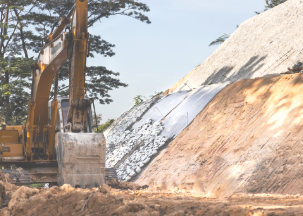
Intech Anchoring Systems, your trusted partner in earth retention solutions. We specialize in providing innovative anchoring systems for a wide range of applications. With our extensive expertise and high-quality products, we ensure reliable and efficient solutions for your earth retention needs.
When dealing with large diameter pipelines or structures that cross wet or submerged areas, buoyancy control is crucial. Our helical ground anchors offer a cost-effective and reliable solution for anti-buoyancy applications. By securely anchoring the pipelines or structures, they prevent costly damage, disruptions, and safety hazards.
Construction and utility industries often require stable and secure guy wire installations. Our helical anchors provide an ideal alternative to traditional methods. With their exceptional load capacity and superior durability, they offer a logical and economical solution to withstand the tension and live loads imposed by wind on guy wires.
Whether for municipal or private harbors, our helical anchor mooring systems offer a secure and reliable solution for marine anchoring. With exceptional stability, ease of installation, and adaptability to diverse marine environments, our mooring solutions provide peace of mind to boat owners and ensure the safety of their vessels.
In restricted access areas or locations with extensive excavation challenges, our helical tieback anchors excel as a solution for permanent retaining wall shoring. These anchors surpass traditional shoring methods by requiring smaller equipment, fewer crew members, and less time for installation. They provide reliable and efficient support, minimizing disruptions and simplifying the construction process.
Our earth retention solutions extend to the construction of seawalls and bulkheads, where stability and durability are critical. By utilizing our helical tieback anchors, we offer a secure and cost-effective method to reinforce these structures and protect against erosion and water intrusion.
For temporary shoring needs, such as restricted access areas or sites with limited excavation possibilities, our helical tieback anchors are the ideal choice. With their streamlined installation process, exceptional load capacity, and adaptability to various soil conditions, they provide reliable support during construction, minimizing downtime and ensuring safety.
At Intech Anchoring Systems, we are committed to providing top-quality earth retention solutions that meet the unique requirements of each project. Our products are manufactured using high-grade materials, ensuring durability and reliability in the most challenging conditions. Additionally, our team of experts is available to provide personalized guidance, from initial consultation to installation support, ensuring successful project outcomes.
Contact us today to discuss your earth retention needs and benefit from our extensive experience in anti-buoyancy, guy anchoring, mooring, permanent shoring, seawalls & bulkheads, and temporary shoring applications. Partner with Intech Anchoring Systems for innovative solutions that deliver exceptional performance, efficiency, and peace of mind.

Tim is the President of Intech Anchoring and has 25 years of experience in the Civil Engineering and Geostructural Industry. Tim has developed extensive industry knowledge by working to support the needs of specialty contractors at each and every business level. Tim’s diverse industry background has given him exposure to a wide variety civil construction projects, ranging from the simplest residential applications to the most complex commercial and industrial projects. Coupled with a highly skilled and educated team, Tim focuses on providing the highest quality products and solutions to Intech Anchoring’s customers in order to consistently exceed expectations.